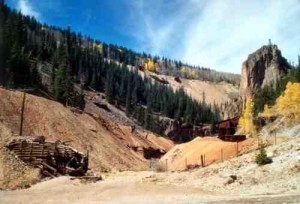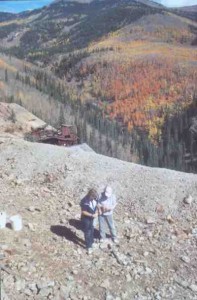Review by Ed Quillen
Ranching – July 2006 – Colorado Central Magazine
A Passion for Ranching – Colorado’s Wet Mountain Valley Heritage
Text and photography by Bill Gillette Foreword by Ed Marston
Sponsored by the West Custer County Library District
Published in 2006 by Westcliffe Publishers
ISBN 1-56579-531-8
THIS IS PRIMARILY a book of photos, and of course it offers some stunning scenery — that’s one of the virtues of the Wet Mountain Valley. But the focus is on ranching, and photographer Bill Gillette captures images so well that your other senses feel engaged. There’s a branding scene where you can almost smell the burning hair. A photo of milling cattle kicking up nose-clogging dust at roundup time makes you want to sneeze. In another picture, a rancher struggles to close a gate during a spring blizzard and you remember just how it feels to have wind-propelled snow slapping your face and cutting through your coat.
These pictures range in scale from wildflower close-ups to vast aerial shots that give us a better perspective on familiar landmarks like the Beckwith Ranch on Highway 69 a few miles north of Westcliffe. Gillette approaches scenes at novel angles, giving us fresh perspectives. And in the process, we can learn a few things. For instance, a mountain-backed meadow glowing with wild iris is indeed beautiful to the eye — but not to the rancher, for the plants are toxic to cattle.
The photography is wonderful. But as much as I enjoyed the pictures, I sometimes had the feeling that I was looking through a family album, and it wasn’t my family, or even third cousins twice removed.
A lot of the pictures are portraits of people I’ve never seen before, and they’re terrific photos, but ranchers don’t necessarily look any different than Salidans or mall shoppers. The book’s intended audience is obviously in Custer County, and maybe locals will know who these people are.
But outsiders like me probably would have understood Custer County ranch life better if there’d been a few more cutlines, which included something other than just people’s last names. Instead, we’re left to imagine something about the lives of the many people whose photographs are featured.
While I did get a fine sense of both the joys and disappointments of ranch life, I never got a good feel for the status of ranching in the Wet Mountain Valley.
One rancher, Randy Rusk, is quoted as saying “When I was a kid, I can tell you, there was 10,000 head of cattle here in the valley and now I am thinking I would be hard-pressed to come up with 2,500 head.” Elsewhere we read that the Wet Mountain Valley grows far more hay than the local cattle can consume, and so it’s a major export crop. So are the ranches turning from cow-calf operations into hay farms that run a few cows?
IT’S HARD TO TELL. Sometimes this has the feel of a documentary about a vanishing way of life. Imports keep beef prices down, land and labor and fuel prices keep rising. A summer afternoon hailstorm can wipe out all the profit on a hay crop, and an April blizzard can kill this year’s calves. Also, the kids can find a better living at scores of other pursuits — without the need to feed cattle at sunrise when it’s below zero in a howling wind.
Then again, the kids quoted here sounded pleased with their ranch lives, which give them significant work and responsibilities at an early age. And the obvious joy and engagement in their pictures at the Custer County Fair are almost contagious.
Further, many ranchers have worked with land conservation trusts to preserve their property for agriculture. They sell the development rights to a non-profit trust, thereby getting some capital, and the valley’s open spaces are protected from 35-acre developments. Thus there’s reason to believe that this book is an exquisite snapshot of early 21st-century ranching, not an obituary for a fading way of life in one of America’s fastest-growing counties, and that there will be operating ranches in the Wet Mountain Valley of 2106.
Of all the early-day industries in Central Colorado, from trapping to mining, railroading, and timbering, only ranching has survived in any significant sense, and the “Passion for Ranching” displayed in this book goes a long way toward explaining that survival. It’s something a family can decide to do, and with good management and some infusions of good luck, keep doing for generations.
For present and former Custer County residents, especially those with ranching connections, this will doubtless be a “must have” book. We “outsiders” may not comprehend all that’s in here, but the fine photography is a pleasure all on its own, and it certainly conveys the passion that the book celebrates.


